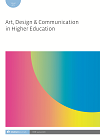
Full text loading...
 , Koray Gelmez1
, Koray Gelmez1
It is difficult, but crucial, to understand the roles of design studio teachers to facilitate the learning processes and improve the teaching approaches. In this respect, the roles of design studio teachers in design education literature are seen rather dispersed. In this study, an integrative literature review of studies was conducted by examining pedagogical roles of design teachers within the frame of the learning processes (cognition, affection and psychomotor). This systematic review aims at wrapping up the literature on the design teacher’s pedagogical role and scrutinizing and mapping the contribution of the design teacher’s pedagogical role in learning processes. The articles reviewed were analysed in terms of their importance given to learning processes through the radar charts. With a critical lens, this review is expected to contribute both to nurture the practice of design teachers and to inform design education literature. Via this, design teachers can get informed and through the mappings offered in this study, and they can also explicitly appreciate their roles and strategies in their design studio courses.

Article metrics loading...

Full text loading...
References


Data & Media loading...

Publication Date:
https://doi.org/10.1386/adch_00041_1 Published content will be available immediately after check-out or when it is released in case of a pre-order. Please make sure to be logged in to see all available purchase options.